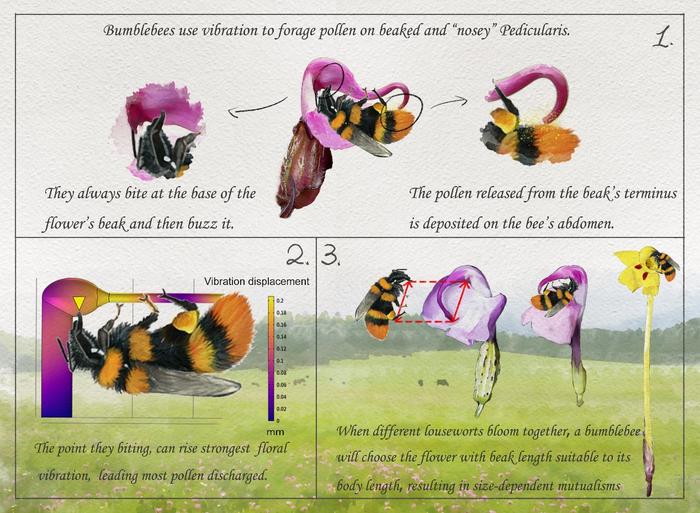In the high-altitude realms of the Himalaya-Hengduan Mountains in southwestern China, a remarkable evolutionary phenomenon unfolds among hundreds of species of lousewort (Pedicularis). These wildflowers have evolved uniquely shaped petals, known as the galea, which bear an uncanny resemblance to elephant heads, complete with elongated beaks that resemble trunks. This extraordinary floral morphology underpins an intricate and highly specialized pollination system involving bumblebees, the sole pollinators of these flowers. Recent multidisciplinary research combining biomechanics, vibrational mechanics, and pollination ecology has shed light on the exquisite precision with which bumblebees interact with these "elephant-nose" flowers to maximize pollen collection and ensure plant reproductive success.
Field observations utilizing multi-angle video recordings captured hundreds of bumblebee visits to various Pedicularis species, revealing a consistent behavioral pattern. Upon arrival, the bumblebee lands precisely on the flower’s beak, immediately biting the base of the "elephant’s head." This biting behavior is no mere happenstance; it is a strategic action that allows the bee to effectively transmit vibrations generated by rapid muscular contractions in her thorax. These vibrations pass from the bee’s chest through her jaws into the floral structure, causing pollen to be ejected specifically from the terminus of the beak. The pollen grains, propelled by this vibration-driven release, land accurately on the bee’s abdomen, from where they are groomed and stored in pollen baskets on the hind legs. Since these flowers produce no nectar, pollen represents the exclusive reward, and in exchange, the bumblebee facilitates cross-pollination by sequentially visiting multiple flowers.
Researchers sought to decipher why bumblebees invariably choose the same biting location on flowers, regardless of the lousewort species in question. Employing advanced structural imaging techniques such as 3D micro-computed tomography (micro-CT) alongside atomic force microscopy (AFM), a comprehensive finite element model of Pedicularis floral architecture was constructed. This model incorporated precise material properties and geometric complexities of the flowers to simulate vibrational responses under buzzing conditions. Finite element analyses illuminated the presence of a singular "optimal biting point," located at the base of the floral beak — the exact position where biting generates maximal vibrational amplitude and, consequently, maximizes pollen expulsion.
Each Pedicularis species produces uniquely sized and shaped elephant-nose flowers, differing markedly in beak length as well as in torsional and coiling characteristics. Intriguingly, bumblebees exhibit a form of size-dependent mutualism; the effectiveness of vibrational pollen extraction hinges on a precise correspondence between the bee’s body length and the floral beak length from the biting point to the beak tip. Bumblebees within a single colony display size polymorphism, with various worker sizes emerging during the summer season. This diversity enables a colony to interact with multiple Pedicularis species simultaneously, with each bee preferentially visiting those flowers that complement its body size. Such "size matching" optimizes pollen collection efficiency while also serving as a reproductive isolating mechanism, preventing hybridization among sympatric lousewort species blooming concurrently on the same mountain slopes.
To further validate the ecological implications of size-based interactions, researchers conducted pollination network analyses at the individual bee level. The results confirmed statistically significant size matching between bee body lengths and floral beak dimensions, underscoring the precision of this mutualistic adaptation both at species-level and individual levels. This phenomenon eloquently explains the coexistence of various elephant-nose species in shared habitats without interspecific gene flow, as different-sized bees specialize on different flowers, maintaining species boundaries through selective pollinator behavior.
From a biomechanical perspective, buzz pollination involves complex vibrational coupling between insect and flower structures. The study’s lead author, Yuanqing Xu, a doctoral candidate at the University of Chinese Academy of Sciences, emphasized the interdisciplinary challenges faced in integrating biomechanical modeling with pollination ecology. The research team successfully combined computational mechanics, in situ vibrational experiments, and ecological network theory to create a holistic framework that unravels how mechanical resonance phenomena govern ecological interactions.
The senior pollination ecologist involved in the study, Professor Peter Bernhardt from the Missouri Botanical Garden, remarked on the elegance of these floral adaptations: "It is as if the flowers communicate to their pollinators with a clear signal—’Bite me here before you shake me!’ The biomechanical design ensures vibrational energy is optimally delivered where needed, facilitating precise pollen release while safeguarding pollen from dispersal to incompatible flowers."
Beyond its contribution to basic plant-pollinator biology, this research offers important applied insights. Buzz pollination is common among angiosperms and is indispensable for the reproductive success of several economically significant crops, including tomatoes and blueberries. An enhanced understanding of vibrational mechanics in pollination can inform better agricultural management practices and support ecological conservation initiatives by highlighting the interconnectedness of pollinator morphology and floral trait evolution.
The study also honors the legacy of Professor Walter A. Macior, a pioneering pollination ecologist who extensively studied Pedicularis species and coined the term "elephant-nose flowers." The paper’s corresponding author, Professor Hong Wang from the Kunming Institute of Botany, reflected on the broader significance of the findings: "These flowers convey more than evolutionary wisdom; they resonate with the enduring spirit of scientific inquiry, transcending generations and geographical borders."
In conclusion, this multidisciplinary investigation reveals how floral biomechanics intricately shape plant-pollinator interactions through vibrational resonance, creating a sophisticated system of mutualism finely tuned by morphological and behavioral traits. The findings not only elucidate the mechanisms underlying floral diversity and speciation but also open new avenues for research in functional ecology and evolutionary biology. As buzz pollination remains a crucial ecosystem service, advancing our mechanistic understanding holds promise for safeguarding biodiversity and agricultural productivity in a changing world.
Subject of Research: Buzz pollination biomechanics and plant-pollinator interactions in Pedicularis species.
Article Title: “Bite Me Here!” Multidisciplinary Research Unlocks Resonance Secret of Buzz Pollination Interactions
Web References: DOI: 10.1007/s11427-024-2858-5
Image Credits: ©Science China Press
Keywords: Buzz pollination, Pedicularis, floral biomechanics, vibrational mechanics, bumblebees, pollination ecology, resonance, finite element model, size-dependent mutualism, plant-pollinator coevolution, vibrational coupling, elephant-nose flowers




